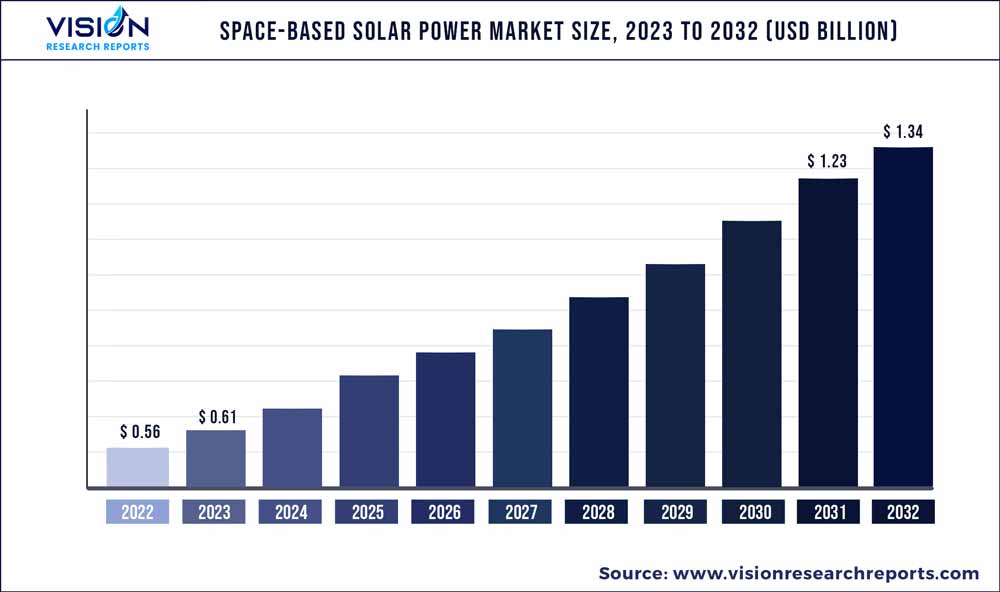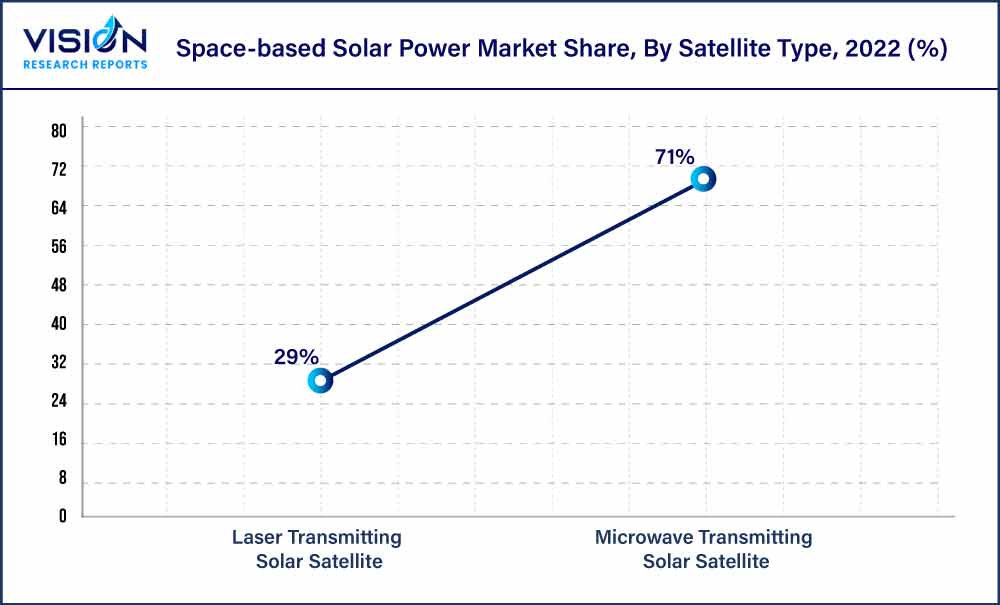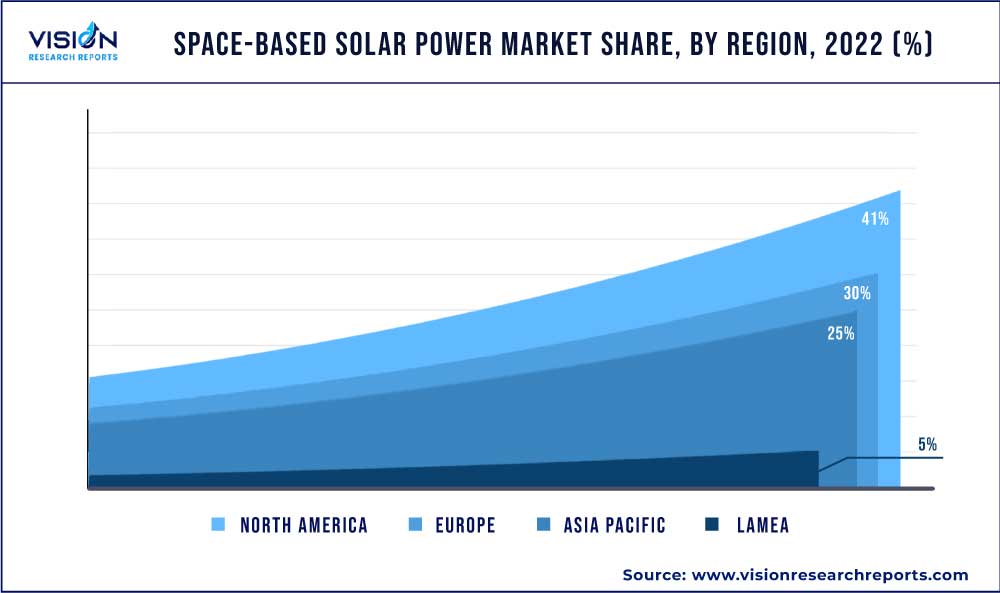The global space-based solar power market size was estimated at around USD 0.56 billion in 2022 and it is projected to hit around USD 1.34 billion by 2032, growing at a CAGR of 9.14% from 2023 to 2032. The space-based solar power market in the United States was accounted for USD 112.2 million in 2022.

Key Pointers
Report Scope of the Space-based Solar Power Market
| Report Coverage | Details |
| Revenue Share of North America in 2022 | 42% |
| Revenue Forecast by 2032 | USD 1.34 billion |
| Growth Rate from 2023 to 2032 | CAGR of 9.14% |
| Base Year | 2022 |
| Forecast Period | 2023 to 2032 |
| Market Analysis (Terms Used) | Value (US$ Million/Billion) or (Volume/Units) |
| Companies Covered | Airborne; AZUR SPACE Solar Power GmbH; Fralock LLC; Japan Aerospace Exploration Agency; Northrop Grumman; Borrego Energy, LLC; Solaren Corporation; SpaceTech GmbH; Space Canada; DHV Technology |
Space-based solar power involves extracting solar energy in space using solar power satellites and transmitting it to receiving stations on Earth. The energy collected from space can be utilized for various purposes, including electricity generation and powering space infrastructure. It plays a crucial role in powering space vehicles, satellites, rovers, and other space infrastructure. By utilizing solar energy from space, these systems can operate for extended durations without frequent refueling or relying on limited onboard energy sources.
The development of reusable rockets, such as SpaceX's Falcon 9, has significantly lowered the expense of launching equipment into space. By landing and refurbishing rockets for future launches, the expenses associated with accessing space have been reduced, making it more economically viable to deploy and maintain space-based solar power infrastructure. The use of robotics and automation in space missions has also played a crucial role in reducing costs and increasing operational efficiency. Robotic systems can perform maintenance and repair tasks on space-based infrastructure, minimizing the need for human intervention and associated costs.
Automation helps streamline operations, improve reliability, and potentially lower the overall expenses of space-based solar power systems. These advancements in space technology along with the growing demand for sustainable and clean energy solutions, are driving the interest and potential market expansion of space-based solar power. As the global focus on sustainable technologies increases, space-based solar power systems present an attractive option for meeting energy needs while reducing reliance on fossil fuels and minimizing environmental impact.
Application Insights
The electricity generation segment held the largest revenue share of over 75% in 2022 owing to a rise in energy demand and cleaner generation of electricity in various industry verticals. Space-based solar power systems can capture solar energy directly in space without the limitations posed by weather conditions or the earth's rotation. This provides a virtually unlimited and constant solar energy source, enabling continuous electricity generation. Furthermore, it can supply power to spacecraft and satellites, ensuring their operations and reducing the need for onboard fuel or limited energy storage. This enables longer missions, extended capabilities, and enhanced functionality for space-based technologies.
The space applications segment is estimated to grow significantly over the forecast period. Space-based solar power can provide a continuous and reliable power source for satellites in space. Satellites require electricity to operate their systems, including communication, navigation, data collection, and scientific instruments. Space-based solar power systems ensure an uninterrupted power supply, reducing the reliance on onboard batteries or limited energy sources. Furthermore, these systems power various space infrastructures, including space habitats, stations, and research facilities. These structures need a reliable and constant energy source for communication, life support systems, experiments, and other activities. Space-based solar power can provide the necessary power for sustained space processes.
Satellite Type Insights
The microwave-transmitting solar satellite segment led the market in 2022 accounting for over 71% share of the global revenue. Microwave-transmitting solar satellites can be positioned in specific orbits that deliver stable and predictable positions relative to the Earth's surface. This allows for consistent and efficient solar energy capture without being impacted by atmospheric conditions or the Earth's rotation, ensuring a steady power supply. As the demand for renewable energy grows, several countries are seeking new power sources beyond Earth. For instance, in January 2023, Japan planned to launch solar panels into orbit and transmit the generated electricity to the ground using microwave beams. UK and China have previously expressed interest in developing this technology, and Japan is the latest to jump on board.

The laser-transmitting solar satellite segment is estimated to grow significantly over the forecast period. Laser-transmitting solar satellites supply power to satellites during periods of the eclipse when they are not directly exposed to sunlight. These satellites can also be employed to supply power to orbital transfer vehicles during their tasks. By beaming power from space, laser-transmitting solar satellites assist in fulfilling the energy needs of these vehicles, reducing the dependence on onboard energy sources. For instance, in June 2022, China planned to launch a solar power plant in space by 2028. The satellite intends to convert solar energy into electricity and then into lasers or microwaves that can be transmitted to different specified targets on Earth.
Regional Insights
North America dominated the market in 2022, accounting for over 42% share of the global revenue. The U.S. is a prominent market for space-based solar power in the region. Players, such as Northrop Grumman and Solaren Corporation, are actively involved in developing space-based solar power technology. The presence of key players in the U.S. is also a key factor driving the market growth in the region. In addition, the government in the region offers funds for research activities identifying the prospect of space-based solar power technology as a source of clean, renewable energy.

Asia Pacific is anticipated to register the fastest CAGR over the forecast period due to the increased investment and R&D in space-based solar power and the presence of a large customer base in the region. Furthermore, India and China have emerged as significant space missions and solar power generation hubs, propelling regional market growth. Furthermore, an increase in knowledge about solar energy and its advantages in harvesting solar power from space rather than earth-based solar power will likely boost market expansion in the Asia Pacific region during the forecast period.
Space-based Solar Power Market Segmentations:
By Satellite Type
By Application
By Regional
Chapter 1. Introduction
1.1. Research Objective
1.2. Scope of the Study
1.3. Definition
Chapter 2. Research Methodology
2.1. Research Approach
2.2. Data Sources
2.3. Assumptions & Limitations
Chapter 3. Executive Summary
3.1. Market Snapshot
Chapter 4. Market Variables and Scope
4.1. Introduction
4.2. Market Classification and Scope
4.3. Industry Value Chain Analysis
4.3.1. Raw Material Procurement Analysis
4.3.2. Sales and Distribution Channel Analysis
4.3.3. Downstream Buyer Analysis
Chapter 5. COVID 19 Impact on Space-based Solar Power Market
5.1. COVID-19 Landscape: Space-based Solar Power Industry Impact
5.2. COVID 19 - Impact Assessment for the Industry
5.3. COVID 19 Impact: Global Major Government Policy
5.4. Market Trends and Opportunities in the COVID-19 Landscape
Chapter 6. Market Dynamics Analysis and Trends
6.1. Market Dynamics
6.1.1. Market Drivers
6.1.2. Market Restraints
6.1.3. Market Opportunities
6.2. Porter’s Five Forces Analysis
6.2.1. Bargaining power of suppliers
6.2.2. Bargaining power of buyers
6.2.3. Threat of substitute
6.2.4. Threat of new entrants
6.2.5. Degree of competition
Chapter 7. Competitive Landscape
7.1.1. Company Market Share/Positioning Analysis
7.1.2. Key Strategies Adopted by Players
7.1.3. Vendor Landscape
7.1.3.1. List of Suppliers
7.1.3.2. List of Buyers
Chapter 8. Global Space-based Solar Power Market, By Satellite Type
8.1. Space-based Solar Power Market, by Satellite Type, 2023-2032
8.1.1. Microwave Transmitting Solar Satellite
8.1.1.1. Market Revenue and Forecast (2020-2032)
8.1.2. Laser Transmitting Solar Satellite
8.1.2.1. Market Revenue and Forecast (2020-2032)
Chapter 9. Global Space-based Solar Power Market, By Application
9.1. Space-based Solar Power Market, by Application, 2023-2032
9.1.1. Electricity Generation
9.1.1.1. Market Revenue and Forecast (2020-2032)
9.1.2. Space Applications
9.1.2.1. Market Revenue and Forecast (2020-2032)
Chapter 10. Global Space-based Solar Power Market, Regional Estimates and Trend Forecast
10.1. North America
10.1.1. Market Revenue and Forecast, by Satellite Type (2020-2032)
10.1.2. Market Revenue and Forecast, by Application (2020-2032)
10.1.3. U.S.
10.1.3.1. Market Revenue and Forecast, by Satellite Type (2020-2032)
10.1.3.2. Market Revenue and Forecast, by Application (2020-2032)
10.1.4. Rest of North America
10.1.4.1. Market Revenue and Forecast, by Satellite Type (2020-2032)
10.1.4.2. Market Revenue and Forecast, by Application (2020-2032)
10.2. Europe
10.2.1. Market Revenue and Forecast, by Satellite Type (2020-2032)
10.2.2. Market Revenue and Forecast, by Application (2020-2032)
10.2.3. UK
10.2.3.1. Market Revenue and Forecast, by Satellite Type (2020-2032)
10.2.3.2. Market Revenue and Forecast, by Application (2020-2032)
10.2.4. Germany
10.2.4.1. Market Revenue and Forecast, by Satellite Type (2020-2032)
10.2.4.2. Market Revenue and Forecast, by Application (2020-2032)
10.2.5. France
10.2.5.1. Market Revenue and Forecast, by Satellite Type (2020-2032)
10.2.5.2. Market Revenue and Forecast, by Application (2020-2032)
10.2.6. Rest of Europe
10.2.6.1. Market Revenue and Forecast, by Satellite Type (2020-2032)
10.2.6.2. Market Revenue and Forecast, by Application (2020-2032)
10.3. APAC
10.3.1. Market Revenue and Forecast, by Satellite Type (2020-2032)
10.3.2. Market Revenue and Forecast, by Application (2020-2032)
10.3.3. India
10.3.3.1. Market Revenue and Forecast, by Satellite Type (2020-2032)
10.3.3.2. Market Revenue and Forecast, by Application (2020-2032)
10.3.4. China
10.3.4.1. Market Revenue and Forecast, by Satellite Type (2020-2032)
10.3.4.2. Market Revenue and Forecast, by Application (2020-2032)
10.3.5. Japan
10.3.5.1. Market Revenue and Forecast, by Satellite Type (2020-2032)
10.3.5.2. Market Revenue and Forecast, by Application (2020-2032)
10.3.6. Rest of APAC
10.3.6.1. Market Revenue and Forecast, by Satellite Type (2020-2032)
10.3.6.2. Market Revenue and Forecast, by Application (2020-2032)
10.4. MEA
10.4.1. Market Revenue and Forecast, by Satellite Type (2020-2032)
10.4.2. Market Revenue and Forecast, by Application (2020-2032)
10.4.3. GCC
10.4.3.1. Market Revenue and Forecast, by Satellite Type (2020-2032)
10.4.3.2. Market Revenue and Forecast, by Application (2020-2032)
10.4.4. North Africa
10.4.4.1. Market Revenue and Forecast, by Satellite Type (2020-2032)
10.4.4.2. Market Revenue and Forecast, by Application (2020-2032)
10.4.5. South Africa
10.4.5.1. Market Revenue and Forecast, by Satellite Type (2020-2032)
10.4.5.2. Market Revenue and Forecast, by Application (2020-2032)
10.4.6. Rest of MEA
10.4.6.1. Market Revenue and Forecast, by Satellite Type (2020-2032)
10.4.6.2. Market Revenue and Forecast, by Application (2020-2032)
10.5. Latin America
10.5.1. Market Revenue and Forecast, by Satellite Type (2020-2032)
10.5.2. Market Revenue and Forecast, by Application (2020-2032)
10.5.3. Brazil
10.5.3.1. Market Revenue and Forecast, by Satellite Type (2020-2032)
10.5.3.2. Market Revenue and Forecast, by Application (2020-2032)
10.5.4. Rest of LATAM
10.5.4.1. Market Revenue and Forecast, by Satellite Type (2020-2032)
10.5.4.2. Market Revenue and Forecast, by Application (2020-2032)
Chapter 11. Company Profiles
11.1. Airborne
11.1.1. Company Overview
11.1.2. Product Offerings
11.1.3. Financial Performance
11.1.4. Recent Initiatives
11.2. AZUR SPACE Solar Power GmbH
11.2.1. Company Overview
11.2.2. Product Offerings
11.2.3. Financial Performance
11.2.4. Recent Initiatives
11.3. Fralock LLC
11.3.1. Company Overview
11.3.2. Product Offerings
11.3.3. Financial Performance
11.3.4. Recent Initiatives
11.4. Japan Aerospace Exploration Agency
11.4.1. Company Overview
11.4.2. Product Offerings
11.4.3. Financial Performance
11.4.4. LTE Scientific
11.5. Northrop Grumman
11.5.1. Company Overview
11.5.2. Product Offerings
11.5.3. Financial Performance
11.5.4. Recent Initiatives
11.6. Borrego Energy, LLC
11.6.1. Company Overview
11.6.2. Product Offerings
11.6.3. Financial Performance
11.6.4. Recent Initiatives
11.7. Solaren Corporation
11.7.1. Company Overview
11.7.2. Product Offerings
11.7.3. Financial Performance
11.7.4. Recent Initiatives
11.8. SpaceTech GmbH
11.8.1. Company Overview
11.8.2. Product Offerings
11.8.3. Financial Performance
11.8.4. Recent Initiatives
11.9. Space Canada
11.9.1. Company Overview
11.9.2. Product Offerings
11.9.3. Financial Performance
11.9.4. Recent Initiatives
11.10. DHV Technology
11.10.1. Company Overview
11.10.2. Product Offerings
11.10.3. Financial Performance
11.10.4. Recent Initiatives
Chapter 12. Research Methodology
12.1. Primary Research
12.2. Secondary Research
12.3. Assumptions
Chapter 13. Appendix
13.1. About Us
13.2. Glossary of Terms
 Cross-segment Market Size and Analysis for
Mentioned Segments
Cross-segment Market Size and Analysis for
Mentioned Segments
 Additional Company Profiles (Upto 5 With No Cost)
Additional Company Profiles (Upto 5 With No Cost)
 Additional Countries (Apart From Mentioned Countries)
Additional Countries (Apart From Mentioned Countries)
 Country/Region-specific Report
Country/Region-specific Report
 Go To Market Strategy
Go To Market Strategy
 Region Specific Market Dynamics
Region Specific Market Dynamics Region Level Market Share
Region Level Market Share Import Export Analysis
Import Export Analysis Production Analysis
Production Analysis Others
Others